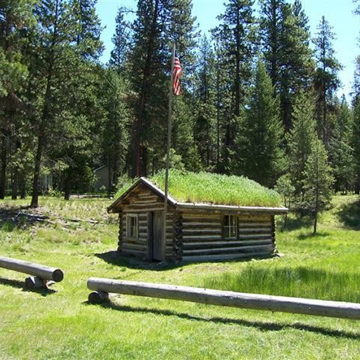Erected in 1898 in Montana’s Bitterroot Forest, the rustic Alta Ranger Station is the oldest known U.S. Forest Service building in the nation. Built with V-notched logs, the cabin is a rudimentary structure typical of late-nineteenth-century frontier buildings. Walls were chinked and daubed to keep out the cold Montana wind; it had a dirt floor and was covered by a sod roof supported on log purlins. Measuring thirteen by fifteen feet, the Alta Ranger Station had just enough room for a ranger to live and carry out a few official duties.
The U.S. Forest Service has its origins in the 1891 Forest Reserve Act though it was the Forest Reserve Act of 1897 that established a vision and framework for the country’s forest system in its intent to “preserve and protect forests” while also furnishing “a continuous supply of timber for the use and necessities of the people of the United States.” Four of the thirteen forest reserves established that year were located in Montana, a century-old legacy reflected today by more than nineteen million wildland acres that lie within Montana’s national forest boundaries.
During the Forest Service’s early years, rangers were entrusted to create and operate a management program. An essential part of this program was erecting or repurposing buildings to house ranger and administrative functions, often by renting office space or running operations from their own homes. Early Forest Service buildings were typically one- or two-room cabins, built with logs harvested from the surrounding forest.
These structures were often built by the ranger himself, generally a jack-of-all-trades outdoorsman who, according to the agency’s first director Gifford Pinchot, “must be able to take care of himself and his horses under very trying conditions; build trails and cabins; ride all day and all night; pack, shoot, and fight fire without losing his head. He must know a good deal about the timber of the country and how to estimate it; he must be familiar with lumbering and the sawmill business, the handling of livestock, mining, and the land laws.”
Deep in the Bitterroot Valley in the Hughes Creek mining district, early-day rangers Nathaniel E. “Than” Wilkerson and Henry C. Tuttle fit this job description. They set about building the Alta Ranger Station with a borrowed horse, cutting and skidding the logs, and purchasing for themselves “hinges, nails, a window, and flag to fly over the building.” Built in just two weeks, the one-room cabin was officially dedicated on July 4, 1899. It served as the ranger station for five years, until it was discovered that Wilkerson and Tuttle had inadvertently erected the building on a private mining claim.
Though the building changed ownership over the years, by the middle of the twentieth century, it was generally recognized that the tiny Alta Station was the oldest standing Forest Service building. By then, hundreds of signatures, dating back to 1899, lined the interior walls. To ensure the preservation of this important ranger station, the Hamilton Lions Club purchased the cabin and donated it back to the Forest Service in 1941.
Though its forest location leaves it vulnerable to the elements, the building survived its first century due to a series of key restoration actions over time, including replacement of the sod roof and setting the cabin on a stone foundation. In 1999, to mark the centennial of its official opening, the Forest Service’s award-winning Northern Region preservation team restored the Alta Ranger Station, making needed repairs and rebuilding the sod roof. Since then, the Forest Service has demonstrated a remarkable level of stewardship of the cabin. When more than 90 fires blazed on the Bitterroot Forest in 2000, fire crews saved the Alta Ranger Station by soaking it down and fully enclosing the building in fire-resistant fabric. Although many non-historic buildings were lost that summer, the Alta Station, along with several other historic buildings in the forest, were saved. When the fire season ended, a smokejumper crew ceremonially unwrapped the cabin and raised an American flag to honor the station’s history and the outstanding efforts by firefighters, preservationists, and volunteers to ensure its longevity for decades to come.
The Alta Ranger Station remains a popular tourist site for visitors to the Bitterroot National Forest and the nearby Alta Campground. It is maintained by volunteers.
References
U.S. Forest Service. “Historic Alta Ranger Station.” U.S. Department of Agriculture. Accessed May 9, 2017. www.fs.usda.gov.






